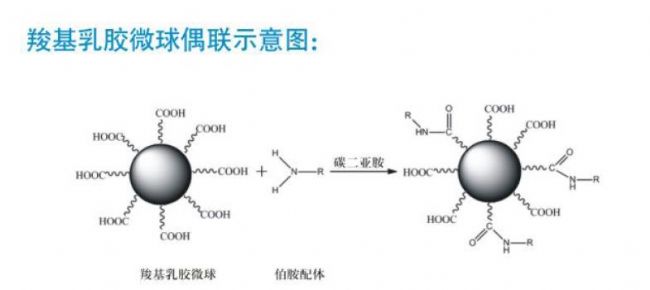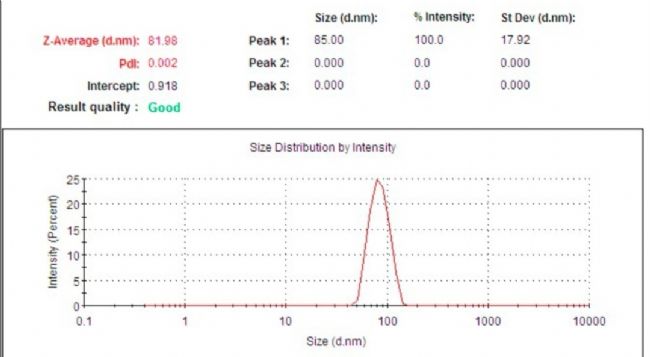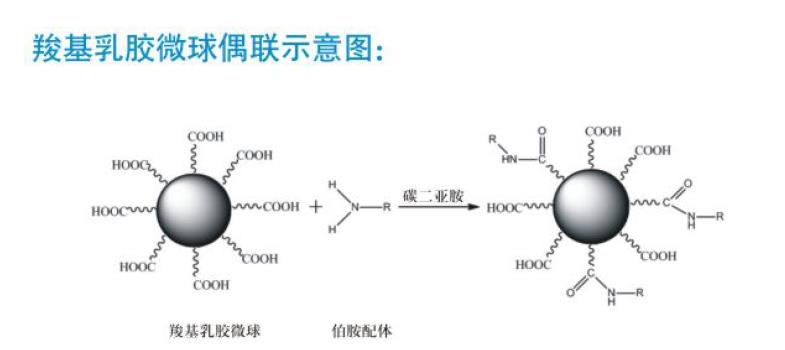Latex microsphere product information
Product Description:
Latex microspheres have a very wide range of applications in immunodiagnosis. Latex microspheres can detect trace amounts of antigens or antibodies in serum, urine, and cerebrospinal fluid. Micro amounts of antibodies can cause significant aggregation of antigen-coated microspheres; The same trace amount of antigen can also cause similar aggregation of antibody coated microspheres.
Another common use is to apply it in latex agglutination inhibition tests. After reacting the antigen in the test sample with known antibodies, mix it with the corresponding antigen coated latex microspheres. Due to the absence of free antibodies, the antigen on the surface of latex particles cannot bind to the antibody, resulting in agglutination, which is suppressed.
For example, if the urine of pregnant women contains HCG, and anti HCG is combined with it, then latex coated with HCG is added, there will be no agglutination phenomenon. Latex microspheres are often used in cell phagocytosis research, with particle sizes ranging from less than 50nm to 3 μ Microspheres of size between m.
There are three kinds of microsphere: carboxyl/amino polystyrene microsphere, carboxyl/amino polymethyl methacrylate microsphere and polystyrene microsphere with blank surface. The carboxyl/amino polystyrene microspheres and the surface blank polystyrene microspheres are made of polystyrene high polymer and crosslinked with divinylbenzene to form a network polymer structure; And the carboxyl/amino polymethyl methacrylate microspheres are made of polymethyl methacrylate. The product is a water dispersible system with excellent mechanical properties, solvent resistance, and resistance to various pH environments. The surface is rich in carboxyl/amino groups and sulfate radicals, which can maintain good stability in the solution and can be applied to various buffer solutions. The surface of the microspheres is smooth and flat, with a large specific surface area and good uniformity, monodispersity, and stability. These carboxyl/amino microspheres can easily covalently couple carboxyl/amino groups with proteins, while surface blank polystyrene microspheres can be connected to proteins through hydrophobic association. It has wide applications in fields such as immunoturbidimetry, immunofluorescence detection, ELISA enhancement, latex agglutination test, etc.
Product advantages:
Product diversification: We can provide microspheres with various particle sizes between 60nm and 700nm;
Good stability: can be stored at room temperature for up to 24 months.
Height uniformity: PDI < 0.050;
High surface carboxyl content: carboxyl content at 200 μ Mol/g~1200 μ Mol/g
Unique preparation process: The carboxyl group is firm and not easy to peel off;
There are no free polymers containing carboxyl groups such as polyacrylic acid in the product;
The strength and toughness of microspheres are excellent: they are not easily mechanically damaged in applications;
Product Usage
1) Immunoturbidimetric reagent, used as an antibody and antigen carrier
2) As a universal support material for enzyme preparation, as a carrier for Immobilized enzyme
3) Development of an ELISA kit as a carrier for secondary antibodies and HRP
4) Particle size standard
application area
Latex microspheres can be used as raw materials for diagnostic reagents to load antibody/antigen molecules, playing a role in signal enhancement in the application of diagnostic reagents. Through the amplification effect of the carrier, the detection sensitivity of diagnostic reagent products can be improved by several orders of magnitude. Mainly applicable in the following aspects
1. Immunofluorescence detection
The principle of immunofluorescence detection is to first immobilize antibodies on the surface of microspheres, and then add a second antibody labeled with fluorescence to bind to the antigen. This results in a stable fluorescence signal of the microsphere antibody antigen second antibody fluorescence labeled complex. After washing, the fluorescence signal is detected using an instrument. There is a strong correlation between the intensity of fluorescence signals and the concentration of detected antigens.
At present, immunofluorescence detection reagent products in the market are: (1) AFP assay kit (immunofluorescence method); (2) Carcinoembryonic antigen quantitative assay kit (time-resolved immunofluorescence method); (3) hepatitis B virus surface antigen assay kit (time-resolved immunofluorescence method); (4) Mycoplasma detection kit (immunofluorescence method); (5) Antinuclear antibody (ANA) Indirect immunofluorescence assay kit, etc.
2 latex particles enhanced immunoturbidimetry
There are two methods for enhancing immune turbidimetry using colloidal particles (PETIA). One is scattering turbidimetric detection, and the other is transmission turbidimetric detection. The basic principle of both methods is to cross link antibodies or antigens on the surface of polymer gel porous microspheres. When the cross linked microspheres with antibodies or antigens are combined with antigens or antibodies, they will quickly gather together in a short time, changing the dispersion or transmittance of the reaction solution. Moreover, there is a strong correlation between the changes in the astigmatism or transmittance (i.e. absorbance) of the reaction solution and the concentration of the tested antigen or antibody, which can reflect the concentration of the tested substance within a certain range
At present, latex immunoturbidimetric reagent products on the market using immunoturbidimetry include: (1) brain rib skin detection reagent: (2) a1 microglobulin detection reagent: (3) Glycated hemoglobin detection reagent: (4) lipoprotein a detection reagent:
(5) High sensitivity C-reactive protein detection reagent; (6) C-reactive protein test reagent: (7) anti Streptolysin "O" test reagent: (8) Retinol binding protein test reagent: (9) Rheumatoid factor test reagent:<10) 132 microglobulin test reagent, (11) neutrophil Gelatinase related lipid carrier protein test reagent:<12) D-dimer test reagent:<13) CK-MB test reagent:<14) Cystatin C test reagent: (15) Myoglobin test reagent; (16) Alpha fetoprotein test reagent: (17) Troponin test reagent: (18) heart type fatty acid binding protein test reagent; Wait a minute.
Enhanced ELISA response
This type of application is based on the principle of ELISA reaction, using latex microspheres with a particle size range of 60-200nm for detection using an enzyme-linked immunosorbent assay (ELISA). The difference is that traditional ELISA reactions use enzyme-linked antibodies, while this application couples enzymes and antibodies to the surface of microspheres, connecting multiple enzyme molecules and antibody molecules on the surface of a microsphere. Replacing the traditional enzyme-linked antibodies labeled with one enzyme molecule and one antibody, microspheres coupled with daytime enzyme molecules and antibody molecules enhance the ELISA reaction.
4 latex agglutination method
Latex agglutination method is an indirect method using latex particles as carriers; Duji test. Namely, by adsorbing or coupling soluble antigens or antibodies onto their surfaces, specific antibodies or antigens bind to them, resulting in clear agglutination of the latex particles. The agglutination reaction was carried out on a glass plate, and the results were observed with naked eyes under good light, and commonly used in thousands of Rheumatoid factor tests.
Product Catalog of Carboxyl Polystyrene Latex Microspheres
| Art. |
Particle size(nm) |
Material quality |
Color/Characteristics |
solids(%) |
Surface groups |
| NMC01 |
60 |
PSt |
milky white |
10% |
-COOH(C)
or
-NH2(N)
Surface blank, no functional groups |
| NMC02 |
70 |
PSt |
milky white |
10% |
| NMC03 |
80 |
PSt |
milky white |
10% |
| NMC04 |
90 |
PSt |
milky white |
10% |
| NMC05 |
100 |
PSt |
milky white |
10% |
| NMC06 |
110 |
PSt |
milky white |
10% |
| NMC07 |
120 |
PSt |
milky white |
10% |
| NMC08 |
130 |
PSt |
milky white |
10% |
| NMC09 |
140 |
PSt |
milky white |
10% |
| NMC10 |
150 |
PSt |
milky white |
10% |
| NMC11 |
160 |
PSt |
milky white |
10% |
| NMC12 |
170 |
PSt |
milky white |
10% |
| NMC13 |
180 |
PSt |
milky white |
10% |
| NMC14 |
190 |
PSt |
milky white |
10% |
| NMC15 |
200 |
PSt |
milky white |
10% |
| NMC16 |
210 |
PSt |
milky white |
10% |
| NMC17 |
220 |
PSt |
milky white |
10% |
| NMC18 |
230 |
PSt |
milky white |
10% |
| NMC19 |
240 |
PSt |
milky white |
10% |
| NMC20 |
250 |
PSt |
milky white |
10% |
| NMC21 |
260 |
PSt |
milky white |
10% |
| NMC22 |
270 |
PSt |
milky white |
10% |
| NMC23 |
280 |
PSt |
milky white |
10% |
| NMC24 |
290 |
PSt |
milky white |
10% |
| NMC25 |
300 |
PSt |
milky white |
10% |
| Description: The product can be dispersed in water or ethanol. |
| Note: Products with any particle size, different concentrations, and carboxyl content can be provided according to customer requirements. |
Note: Adding (C) or (N) after the product number is used to distinguish whether the surface of the microspheres is carboxyl or amino.
The following are the characteristic data of some types of microspheres using Marvin laser particle size instruments


At the same time, we compared the characteristic parameters of Marvin laser particle size instruments for three imported products from abroad



bio-equip.cn









